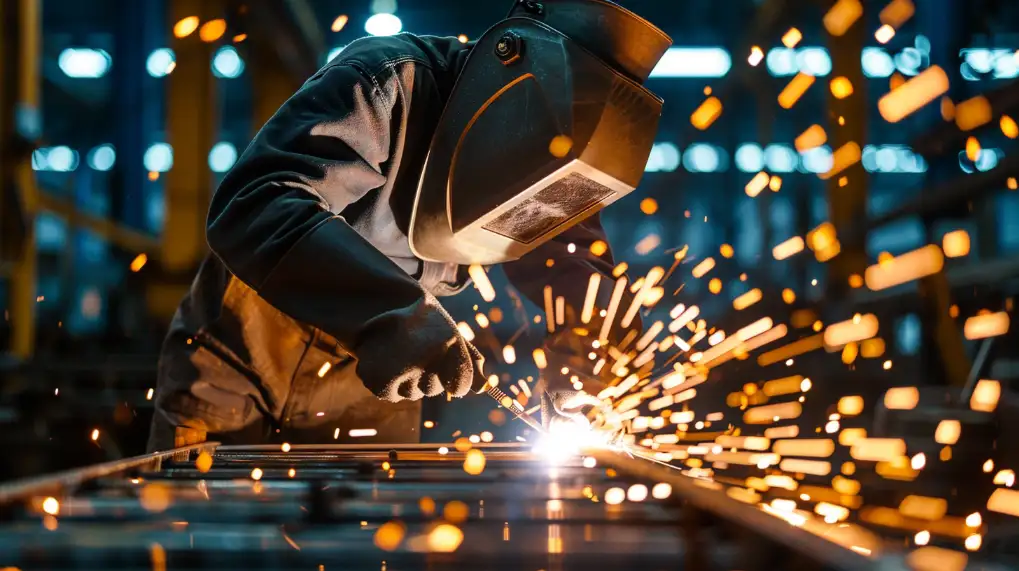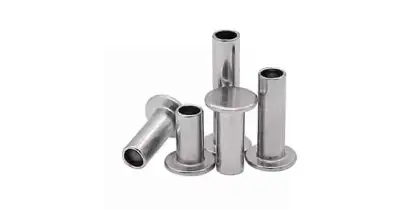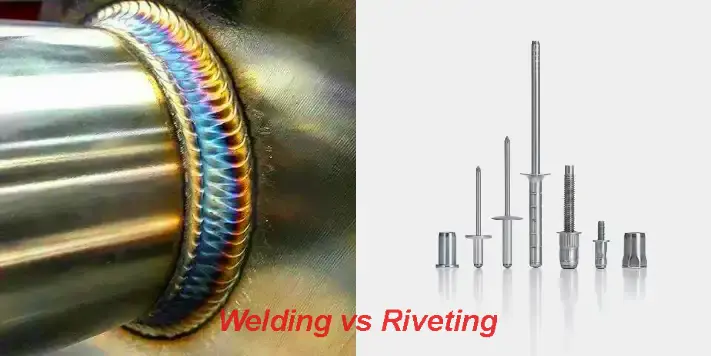Choosing the correct method is crucial when deciding how to join materials for your project. Welding and riveting are standard options, but how do you decide which suits your needs? Choosing the wrong method can lead to high costs, delays, and safety issues. This blog post will explore the pros and cons of welding and riveting, helping you make the best decision for your project.
Welding fuses materials, creating a strong, permanent bond. Riveting uses mechanical fasteners, allowing for disassembly and better stress distribution. Your choice depends on material type, project needs, and budget.
Which method you choose depends on your project’s specific needs. If you’re unsure about the best option, continue reading to learn more about the benefits and challenges of each technique.
What is Welding?
Welding is a process used to join two or more materials together. It involves applying heat or pressure to melt the materials at the joining point. Once cooled, the materials fuse, forming a strong bond. Welding is commonly used in manufacturing, construction, and automotive industries to create strong and permanent connections.
Types of Welding Techniques
Different welding techniques suit various needs. Here’s how four standard methods compare for strength, speed, and ease of use.
MIG Welding
MIG welding uses a continuous wire electrode and shielding gas to join metals. It is easy to learn and works well with thin to medium-thick materials. MIG welding is fast and produces clean, precise welds.
TIG Welding
TIG welding is known for its precision. It uses a non-consumable tungsten electrode and a separate filler rod. TIG welding is best for thin materials. It provides clean welds with minimal spatter.
Stick Welding
Stick welding, also called Shielded Metal Arc Welding (SMAW), uses a consumable electrode coated in flux. It’s a versatile method that works well with various materials and thicknesses. Stick welding is suitable for outdoor use and harsh environments.
Spot Welding
Spot welding is a resistance welding method. It joins two metal pieces by applying heat and pressure at specific points. This technique is often used in the automotive industry to attach sheet metal.
Key Advantages of Welding
Welding outperforms other methods in critical ways. Here’s why it’s the go-to for permanent, high-strength joints.
Strength and Durability
Welding creates strong, permanent joints that can support heavy loads. It is one of the most reliable methods for high-strength applications and ensures long-lasting durability.
Seamless Joint Formation
Welded joints are continuous and smooth, unlike riveted connections. This provides a more aesthetically pleasing finish and better performance under high pressure.
Versatility in Material Selection
Welding can be used on many metals, including steel, aluminum, and stainless steel. It’s a flexible method that works with different materials and thicknesses.
Limitations of Welding
Welding isn’t perfect for every scenario. These trade-offs could impact your project’s cost and timeline.
High Equipment Costs
Welding requires specialized equipment, which can be costly. Advanced techniques like TIG or MIG welding, in particular, need more expensive tools. This can increase the initial investment for your project.
Skill Requirements
Welding requires skilled workers. A poor technique can result in weak or faulty welds, leading to costly repairs or rework.
Potential for Distortion and Warping
Heating metal can cause it to expand and contract, leading to distortion or warping, especially with thicker materials or large areas. Proper control is necessary to avoid these issues.

What is Riveting?
Riveting is a fastening process that uses a metal pin, called a rivet, to join two or more materials. The rivet is inserted into a hole and then deformed to hold the materials together. This creates a permanent bond, making riveting useful in the construction, aerospace, and automotive industries.
Types of Rivets
Not all rivets work the same way. These common types solve different fastening challenges.
Solid Rivets
Solid rivets are one of the oldest and most widely used types. They are placed into pre-drilled holes and then deformed on both ends to form a secure joint. These rivets provide strong, reliable connections but require special tools and skills.
Blind Rivets
Blind rivets are used when one side of the materials is hard to reach. When the tool is applied, the rivet expands and forms a tight joint, making it ideal for situations with limited access.
Pop Rivets
Pop rivets are blind rivets, often used in light-duty applications. They are inserted into the material and “popped” with a special tool to create a secure joint. These rivets are simple to use and are common in automotive and construction work.
Key Advantages of Riveting
Riveting beats welding in specific situations. Here’s where mechanical fasteners shine.
Simplicity and Cost-Effectiveness
Riveting is a simple process that requires minimal training and tools compared to welding. It is also more affordable for small to medium projects, making it a popular choice for many manufacturers.
No Need for Heat
Unlike welding, riveting does not require heat. This makes it ideal for materials that can’t tolerate high temperatures, like certain plastics or thin metals.
Better for Thin Materials
Riveting is especially effective for joining thin materials, such as sheet metal. It does not require as much preparation or heat, making it safer and easier for these applications.
Limitations of Riveting
Rivets have apparent drawbacks, too. These factors could affect your project’s success.
Lower Strength Compared to Welding
While riveting provides strong bonds, it usually doesn’t match the strength of welded joints. This can be a limitation in projects where strength is crucial, like heavy machinery or structural components.
Limited Flexibility in Material Selection
Riveting is less versatile than welding. It is mainly used for metals and may not work well with some composites or plastics. Welding, on the other hand, can handle a broader range of materials.
Potential for Leakages in Some Applications
Rivets can sometimes leave small gaps, such as pressure vessels or watertight enclosures. These gaps may cause leaks, a significant limitation when an airtight or watertight seal is required.

Welding vs Riveting: A Head-to-Head Comparison
Choosing between welding and riveting depends on several factors that affect performance, cost, and ease. Let’s compare these two methods based on key aspects to help you decide.
Strength and Durability: Which is More Reliable?
Welding creates a stronger and more durable bond than riveting. The seamless joint formed by welding offers better strength, especially in high-stress or heavy-load situations. Riveting provides a reliable connection but is generally weaker.
Speed and Efficiency
Riveting is usually faster than welding, especially for simple projects or materials that don’t need heat treatment. It also requires less preparation. Welding can take longer, particularly for detailed or high-precision work.
Cost Analysis: Welding vs Riveting
Riveting is generally more affordable in terms of equipment and labor. The tools needed for riveting are cheaper, and the learning curve for operators is shorter. Welding equipment can be expensive, especially for advanced techniques like TIG or MIG welding. Welding also requires skilled labor, which can raise overall project costs.
Material Compatibility and Application Range
Welding is more versatile for different materials. It works on a wide range of metals, both thick and thin. Riveting, however, is best for thinner materials and less effective for thick sections or certain alloys.

When to Choose Welding?
Welding is ideal when you need strong, durable joints, especially in complex or heavy-duty applications. Here are the key situations where welding stands out.
Complex Joints and Heavy-Duty Applications
High Strength Requirements
Welding is perfect for projects that need high strength. It creates a continuous bond, which is stronger and more reliable than mechanical fasteners like rivets. Welding ensures the joints can handle heavy loads for high-stress parts, such as structural steel or pressure vessels.
Large-Scale Projects
Welding works well for large-scale production, especially when precision and strength are needed. It can be automated for mass production, making it an efficient choice for high-volume parts. Industries like automotive, aerospace, and construction rely on welding for its consistency and durability.
Ideal Materials for Welding
Steel and Stainless Steel
Steel, including stainless steel, is one of the most common materials for welding. It is strong and versatile, perfect for construction, pipelines, and heavy machinery applications.
Aluminum and Alloys
Aluminum welding is more challenging due to its low melting point and high heat conductivity. However, it is widely used in aerospace, automotive, and marine industries. Welding titanium and other alloys are also standard in high-performance applications.
When Not to Use Welding?
Thin Materials
Welding may not be suitable for fragile materials because the heat can cause warping or even burn through the material. Other joining methods like riveting or adhesive bonding might be better options in these cases.
Temperature-Sensitive Components
Some materials, such as certain plastics or sensitive electronics, can be damaged by the heat used in welding. Alternatives like riveting are a better choice for components that can’t withstand high temperatures.
When to Choose Riveting?
Riveting is an excellent option for projects that require simplicity, cost-effectiveness, and reliability. Here are the key scenarios where riveting is the best choice.
Simplicity and Low-Cost Solutions
Small-Scale Manufacturing
Riveting is ideal for small-scale manufacturing or prototype work. It doesn’t require expensive equipment or highly skilled labor, making it a cost-effective solution for low-volume production runs. Riveting is particularly useful for businesses that need to assemble parts quickly with minimal investment.
Lightweight Materials
Riveting works well with lightweight materials such as thin sheet metal, plastics, and lightweight alloys. It is a simple process that doesn’t require high heat, making it perfect for materials sensitive to temperature changes or prone to distortion under heat.
Ideal Materials for Riveting
Aluminum
Aluminum is one of the most common materials used in riveting. Its lightweight and corrosion resistance makes it perfect for applications in industries like aerospace, automotive, and construction. Riveting ensures a strong bond without the heat that could distort or damage the material.
Plastic and Sheet Metal
Riveting is ideal for joining plastic components or thin sheet metal. The process doesn’t require high temperatures, which makes it a good choice for materials that could melt or deform under heat, such as certain plastics or delicate metals.
When Not to Use Riveting?
High-Strength Requirements
Riveting is not ideal when your project requires extremely high strength. While rivets are reliable for many applications, they are generally not as strong as welded joints. Welding is a better choice for structural or heavy-duty applications that require maximum strength.
Complex Shapes and Geometries
Riveting is limited to complex shapes or geometries. It may be challenging to place rivets in intricate designs or hard-to-reach areas. In such cases, welding or other advanced joining techniques offer a better solution to meet design and structural requirements.
Hybrid Use of Welding and Riveting
Combining welding and riveting can be the best solution for many projects. It is often used in complex applications where high strength and ease of assembly are needed.
When to Combine Welding and Riveting?
Welding and riveting are sometimes used together in projects. Some parts may need the strength and durability of welding, while other parts benefit from the simplicity and cost-effectiveness of riveting.
For example, welding is used in high-stress areas where strength is critical, while riveting can be applied to lighter, less demanding sections. This approach helps optimize performance and cost.
Benefits of Hybrid Use
The hybrid approach allows manufacturers to get the best of both techniques. Welding provides strong, durable bonds in high-stress areas, while riveting works well for parts that need to be lightweight or assembled quickly without heat.
Combining these methods also helps reduce material distortion, as riveting doesn’t involve heat, minimizing the risk of warping in sensitive areas.
Conclusion
Choosing between welding and riveting depends on your project’s specific needs. Welding offers strength, durability, and versatility, making it ideal for high-stress applications and heavy-duty components. Riveting is a simpler, cost-effective solution that works well for lightweight materials and low-volume production.
Do you need assistance in choosing the best joining method for your project? Contact us today to discuss your requirements, and let’s find the perfect solution tailored to your needs!
FAQs
Which method is more cost-effective for small projects?
Riveting is generally more cost-effective for small projects. It requires less expensive equipment and can be done with fewer specialized skills. The process is quicker and more straightforward, ideal for low-volume or small-scale manufacturing.
Can welding be used for all metals?
Welding can be used for most metals, including steel, stainless steel, aluminum, and even some alloys. However, certain materials, such as some plastics or heat-sensitive metals, may not be suitable for welding due to the heat involved.
Which technique gives higher strength, riveting or welding?
Welding provides higher strength than riveting. It creates a continuous bond, making it stronger and more durable, especially in high-stress or heavy-duty applications. Riveting is reliable but generally offers less strength than welded joints.
Is riveting permanent or temporary?
Riveting is a permanent joining method. Once rivets are applied and deformed, they cannot be undone without cutting or removing the rivet. However, unlike welding, rivets do not create a seamless joint, which may impact their performance in some high-strength applications.
More Resources:
Optimal Materials for Riveting – Source: Essentra Components
Latest Advances in Welding Technology – Source: Yeswelder
Hey, I'm Kevin Lee

For the past 10 years, I’ve been immersed in various forms of sheet metal fabrication, sharing cool insights here from my experiences across diverse workshops.
Get in touch

Kevin Lee
I have over ten years of professional experience in sheet metal fabrication, specializing in laser cutting, bending, welding, and surface treatment techniques. As the Technical Director at Shengen, I am committed to solving complex manufacturing challenges and driving innovation and quality in each project.
